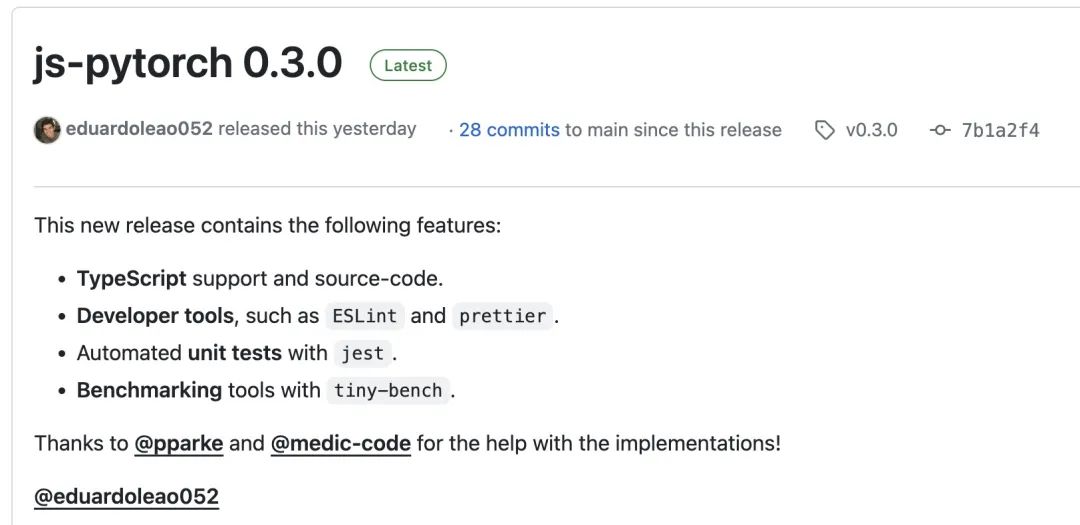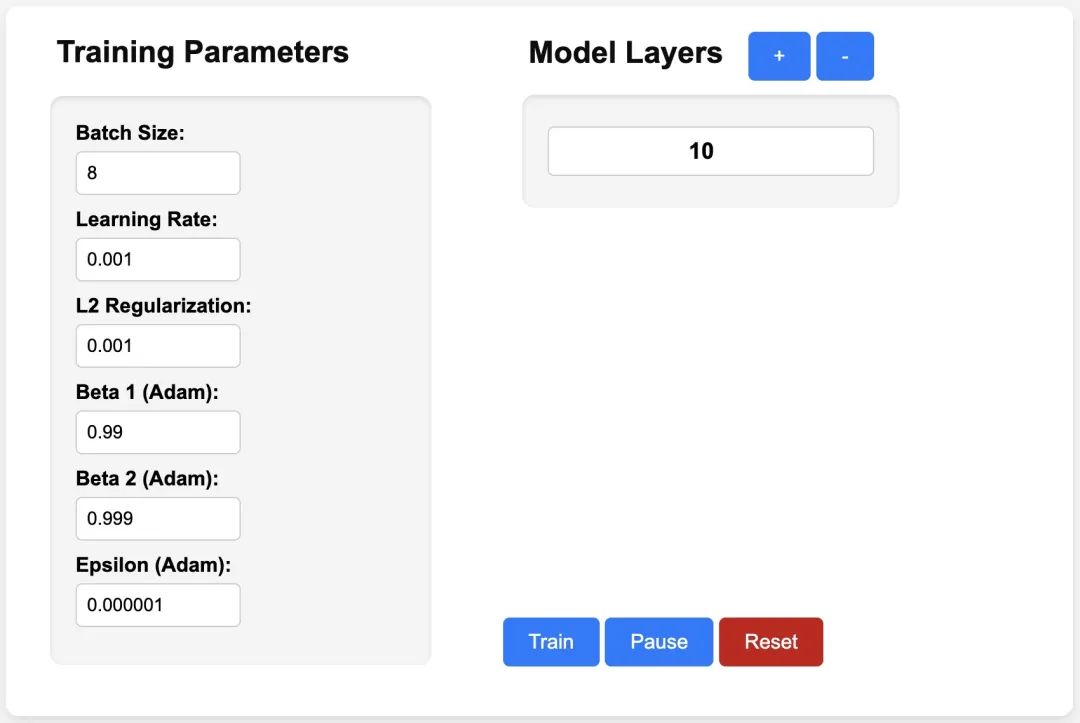The AI era of JS is here!
JS-Torch Introduction
JS-Torch is a deep learning JavaScript library whose syntax is very similar to PyTorch. It contains a fully functional tensor object (can be used with tracked gradients), deep learning layers and functions, and an automatic differentiation engine. JS-Torch is suitable for deep learning research in JavaScript and provides many convenient tools and functions to accelerate deep learning development.
 Picture
Picture
PyTorch is an open source deep learning framework developed and maintained by Meta's research team. It provides a rich set of tools and libraries for building and training neural network models. The design concept of PyTorch is simplicity, flexibility and ease of use. Its dynamic calculation graph feature makes model construction more intuitive and flexible, while also improving the efficiency of model construction and debugging. The dynamic calculation graph feature of PyTorch also makes its model construction more intuitive and easy to debug and optimize. In addition, PyTorch also has good scalability and operating efficiency, making it popular and applied in the field of deep learning.
You can install js-pytorch through npm or pnpm:
npm install js-pytorchpnpm add js-pytorch
or experience the Demo[3] provided by js-pytorch online:
 Picture
Picture
##https://eduardoleao052.github.io/js-torch/assets/demo/demo.htmlJS-Torch supported functionsCurrently, JS-Torch already supports tensor operations such as Add, Subtract, Multiply, and Divide, and also supports commonly used deep learning layers such as Linear, MultiHeadSelfAttention, ReLU, and LayerNorm. Tensor Operations
- Add
- Subtract
- Multiply
- Divide
- Matrix Multiply
- Power
- Square Root
- Exponentiate
- Log
- Sum
- Mean
- Variance
- Transpose
- At
- MaskedFill
- Reshape
- nn.Linear
- nn.MultiHeadSelfAttention
- nn.FullyConnected
- nn.Block
- nn.Embedding
- nn.PositionalEmbedding
- nn.ReLU
- nn.Softmax
- nn.Dropout
- nn.LayerNorm
- nn.CrossEntropyLoss
import { torch } from "js-pytorch";// Instantiate Tensors:let x = torch.randn([8, 4, 5]);let w = torch.randn([8, 5, 4], (requires_grad = true));let b = torch.tensor([0.2, 0.5, 0.1, 0.0], (requires_grad = true));// Make calculations:let out = torch.matmul(x, w);out = torch.add(out, b);// Compute gradients on whole graph:out.backward();// Get gradients from specific Tensors:console.log(w.grad);console.log(b.grad);import { torch } from "js-pytorch";const nn = torch.nn;class Transformer extends nn.Module {constructor(vocab_size, hidden_size, n_timesteps, n_heads, p) {super();// Instantiate Transformer's Layers:this.embed = new nn.Embedding(vocab_size, hidden_size);this.pos_embed = new nn.PositionalEmbedding(n_timesteps, hidden_size);this.b1 = new nn.Block(hidden_size,hidden_size,n_heads,n_timesteps,(dropout_p = p));this.b2 = new nn.Block(hidden_size,hidden_size,n_heads,n_timesteps,(dropout_p = p));this.ln = new nn.LayerNorm(hidden_size);this.linear = new nn.Linear(hidden_size, vocab_size);}forward(x) {let z;z = torch.add(this.embed.forward(x), this.pos_embed.forward(x));z = this.b1.forward(z);z = this.b2.forward(z);z = this.ln.forward(z);z = this.linear.forward(z);return z;}}// Instantiate your custom nn.Module:const model = new Transformer(vocab_size,hidden_size,n_timesteps,n_heads,dropout_p);// Define loss function and optimizer:const loss_func = new nn.CrossEntropyLoss();const optimizer = new optim.Adam(model.parameters(), (lr = 5e-3), (reg = 0));// Instantiate sample input and output:let x = torch.randint(0, vocab_size, [batch_size, n_timesteps, 1]);let y = torch.randint(0, vocab_size, [batch_size, n_timesteps]);let loss;// Training Loop:for (let i = 0; i < 40; i++) {// Forward pass through the Transformer:let z = model.forward(x);// Get loss:loss = loss_func.forward(z, y);// Backpropagate the loss using torch.tensor's backward() method:loss.backward();// Update the weights:optimizer.step();// Reset the gradients to zero after each training step:optimizer.zero_grad();}The above is the detailed content of The AI era of JS is here!. For more information, please follow other related articles on the PHP Chinese website!

Hot AI Tools

Undresser.AI Undress
AI-powered app for creating realistic nude photos

AI Clothes Remover
Online AI tool for removing clothes from photos.

Undress AI Tool
Undress images for free

Clothoff.io
AI clothes remover

Video Face Swap
Swap faces in any video effortlessly with our completely free AI face swap tool!

Hot Article

Hot Tools

Notepad++7.3.1
Easy-to-use and free code editor

SublimeText3 Chinese version
Chinese version, very easy to use

Zend Studio 13.0.1
Powerful PHP integrated development environment

Dreamweaver CS6
Visual web development tools

SublimeText3 Mac version
God-level code editing software (SublimeText3)

Hot Topics
 1655
1655
 14
14
 1414
1414
 52
52
 1307
1307
 25
25
 1254
1254
 29
29
 1228
1228
 24
24
 How much is Bitcoin worth
Apr 28, 2025 pm 07:42 PM
How much is Bitcoin worth
Apr 28, 2025 pm 07:42 PM
Bitcoin’s price ranges from $20,000 to $30,000. 1. Bitcoin’s price has fluctuated dramatically since 2009, reaching nearly $20,000 in 2017 and nearly $60,000 in 2021. 2. Prices are affected by factors such as market demand, supply, and macroeconomic environment. 3. Get real-time prices through exchanges, mobile apps and websites. 4. Bitcoin price is highly volatile, driven by market sentiment and external factors. 5. It has a certain relationship with traditional financial markets and is affected by global stock markets, the strength of the US dollar, etc. 6. The long-term trend is bullish, but risks need to be assessed with caution.
 Which of the top ten currency trading platforms in the world are the latest version of the top ten currency trading platforms
Apr 28, 2025 pm 08:09 PM
Which of the top ten currency trading platforms in the world are the latest version of the top ten currency trading platforms
Apr 28, 2025 pm 08:09 PM
The top ten cryptocurrency trading platforms in the world include Binance, OKX, Gate.io, Coinbase, Kraken, Huobi Global, Bitfinex, Bittrex, KuCoin and Poloniex, all of which provide a variety of trading methods and powerful security measures.
 Which of the top ten currency trading platforms in the world are among the top ten currency trading platforms in 2025
Apr 28, 2025 pm 08:12 PM
Which of the top ten currency trading platforms in the world are among the top ten currency trading platforms in 2025
Apr 28, 2025 pm 08:12 PM
The top ten cryptocurrency exchanges in the world in 2025 include Binance, OKX, Gate.io, Coinbase, Kraken, Huobi, Bitfinex, KuCoin, Bittrex and Poloniex, all of which are known for their high trading volume and security.
 What are the top ten virtual currency trading apps? The latest digital currency exchange rankings
Apr 28, 2025 pm 08:03 PM
What are the top ten virtual currency trading apps? The latest digital currency exchange rankings
Apr 28, 2025 pm 08:03 PM
The top ten digital currency exchanges such as Binance, OKX, gate.io have improved their systems, efficient diversified transactions and strict security measures.
 Decryption Gate.io Strategy Upgrade: How to Redefine Crypto Asset Management in MeMebox 2.0?
Apr 28, 2025 pm 03:33 PM
Decryption Gate.io Strategy Upgrade: How to Redefine Crypto Asset Management in MeMebox 2.0?
Apr 28, 2025 pm 03:33 PM
MeMebox 2.0 redefines crypto asset management through innovative architecture and performance breakthroughs. 1) It solves three major pain points: asset silos, income decay and paradox of security and convenience. 2) Through intelligent asset hubs, dynamic risk management and return enhancement engines, cross-chain transfer speed, average yield rate and security incident response speed are improved. 3) Provide users with asset visualization, policy automation and governance integration, realizing user value reconstruction. 4) Through ecological collaboration and compliance innovation, the overall effectiveness of the platform has been enhanced. 5) In the future, smart contract insurance pools, forecast market integration and AI-driven asset allocation will be launched to continue to lead the development of the industry.
 Recommended reliable digital currency trading platforms. Top 10 digital currency exchanges in the world. 2025
Apr 28, 2025 pm 04:30 PM
Recommended reliable digital currency trading platforms. Top 10 digital currency exchanges in the world. 2025
Apr 28, 2025 pm 04:30 PM
Recommended reliable digital currency trading platforms: 1. OKX, 2. Binance, 3. Coinbase, 4. Kraken, 5. Huobi, 6. KuCoin, 7. Bitfinex, 8. Gemini, 9. Bitstamp, 10. Poloniex, these platforms are known for their security, user experience and diverse functions, suitable for users at different levels of digital currency transactions
 What are the top currency trading platforms? The top 10 latest virtual currency exchanges
Apr 28, 2025 pm 08:06 PM
What are the top currency trading platforms? The top 10 latest virtual currency exchanges
Apr 28, 2025 pm 08:06 PM
Currently ranked among the top ten virtual currency exchanges: 1. Binance, 2. OKX, 3. Gate.io, 4. Coin library, 5. Siren, 6. Huobi Global Station, 7. Bybit, 8. Kucoin, 9. Bitcoin, 10. bit stamp.
 Bitcoin price today
Apr 28, 2025 pm 07:39 PM
Bitcoin price today
Apr 28, 2025 pm 07:39 PM
Bitcoin’s price fluctuations today are affected by many factors such as macroeconomics, policies, and market sentiment. Investors need to pay attention to technical and fundamental analysis to make informed decisions.




